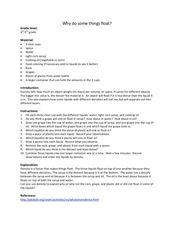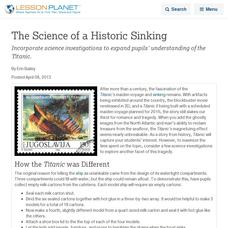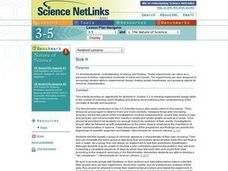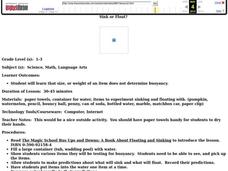Sink or Float Teacher Resources
Hi, What do you want to do?
Find Sink or Float lesson plans and worksheets
Showing 462 resources
Lesson Planet Curated
Inquiry in Action: Second Grade Chapter 4 - Float and Sink
Chapter four in the Inquiry in Action module has learners explore what objects sink and float in water. In the inquiry-based lesson plan, young scientists conduct experiments to find similarities between float materials and those that sink.
Lesson Planet Curated
Inquiry in Action: Second Grade
The six-unit modules in the Inquiry in Action curriculum set is designed for second graders. With hands-on instructional activities and experiments, young scholars investigate the properties of materials, liquids, and dissolving is a...
Lesson Planet Curated
TeachEngineering: Floaters and Sinkers
Why do some objects sink while others float? That’s the question young engineers tackle in a unit module of two lessons and three activities. With some help from Archimedes (and his principle) and the principle of buoyancy, scholars...
Lesson Planet Curated
Middle School Chemistry: Chapter 3 - Density
Chapter three in the middle school chemistry unit explores the relationship between volume and density. Young chemists conduct experiments to find volume through displacement, observe how temperature affects water density, and how the...
Lesson Planet Curated
Inquiry in Action: Fifth Grade
The Inquiry in Action: Fifth Grade Curriculum set contains five chapters, comprised of 16 lessons, activity sheets, videos, and other resources to help explain science concepts to young learners. In Chapter 1 - Matter is Made of Tiny...
Lesson Planet Curated
Inquiry in Action: Fifth Grade Chapter 2 - Substances Have Characteristic Properties
The five lessons in Chapter 2 ask fifth graders to use their observation skills to identify substances. They dissolve known and unknown substances to determine the identity of the mystery substances. Next, learners investigate the...
Lesson Planet Curated
Inquiry in Action: 5th Grade Science Lessons
Looking for remote learning science lessons aligned to NGSS? Check out the resources in this inquiry-in-action packet. Designed for fifth graders, the 16 lessons are divided into four chapters: Matter is Mad of Tiny Particles, Substances...
Curated OER
Sink/Float Discovery bottle
Investigate which items float and which ones sink using this resource. Learners participate in an activity in which they investigate this phenomena. Then they describe the experimental process, and learn how to display their results.
Curated OER
Natalie Morales: Float
Natalie Morales performs a simple experiment to show what the word float means by placing a pumpkin in water. This video could be used as an introduction to a science experiment on buoyancy. It would be fun to have your class experiment...
Curated OER
Sink or Float?
Students investigate whether different objects sink or float in water using the Scientific Method. They listen to the book "Christopher Columbus" by Stephen Krensky, identify the steps of the Scientific Method, conduct the sink or float...
Curated OER
Sink or Float?
Have your class explore density and buoyancy using this resource. Learners read the book Who Sank the Boat, and use several items, such as rubber balls, bottle caps, wood, and other household items to conduct an experiment. Using a tub...
American Chemical Society
Density: Sink and Float for Solids
Steal cubes sink, but steal ships float. Lesson explores the density of solids as well as the density of water in determining what will sink and what will float. A hands-on group activity helps pupils see that weight and volume are...
Curated OER
Will It Sink Or Float?
Learners develop their understanding of buoyancy and density related to sinking and floating. They investigate which objects sink and float through experimentation. They determine that different substances sink or float depending on...
Curated OER
Physical Science- Sink or Float?
Learners investigate which objects sink and which ones float. Learners engage in an experiment, make predictions, and record results on a graphic organizer. This is a comprehensive and easy to follow resource.
Curated OER
Why Do Some Things Float?
Learners recognize that density determines whether objects sink or float. In this sink or float lesson plan, students experiment with plastic in three liquids. learners drop their objects into the liquids and observe and record...
Curated OER
Floating and Sinking - An Investigation
A simple and effective presentation could be helpful for your young scientists. Learners consider whether or not a piece of wood, glass, cork, brick, and ice will float or sink when placed in water. After the class has made their...
US Department of Agriculture
Sink or Float?
Will it sink or will it float? Learners predict the outcome as they drop random objects into a container of water. Then, they keep track of the results and record the data in a t-chart to draw a final conclusion.
Curated OER
How to Float an Egg
Use the scientific method to experiment with an egg. Your class can examine buoyancy and density by finding how many spoons of salt are needed to float an egg. They can predict, experiment, record data, and analyze results.
Curated OER
The Science of a Historic Sinking
Incorporate science investigations to expand pupils' understanding of the Titanic.
Curated OER
Sink It
Introduce your class to the concept of sinking and floating. In groups, they classify objects after making predictions about which materials will sink or float. They record their results and create graphs and charts to share with the class.
Steve Spangler Science
Sinking Soda Surprise - Cool Science Experiment
I'm sure you've heard that there are something like 20 tablespoons of sugar in a can of regular soda. It seems unbelievable, doesn't it? This demonstration really does show how much sugar is present in a can of soda. First, Spangler...
Curated OER
Will It Sink Or Float?
Have your class predict whether objects will sink or float in water. Learners consider a data table of mass, volume and whether the object sank or floated. They develop an evidence-based explanation for the results.
Curated OER
Will It Sink or Float?
Learners conduct a science experiment to determine whether a variety of objects will sink or float. They discuss the concept of density, and then make predictions about whether the objects will sink or float. They then conduct the...
Curated OER
Sink or Float?
Students predict and test different items to see if they sink or float. In this sink and float lesson plan, students predict whether an item is buoyant or not, and learn that size and weight do not matter when it comes to buoyancy.






















